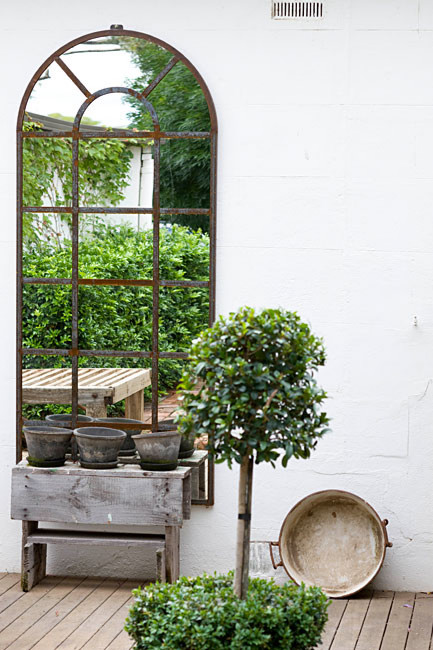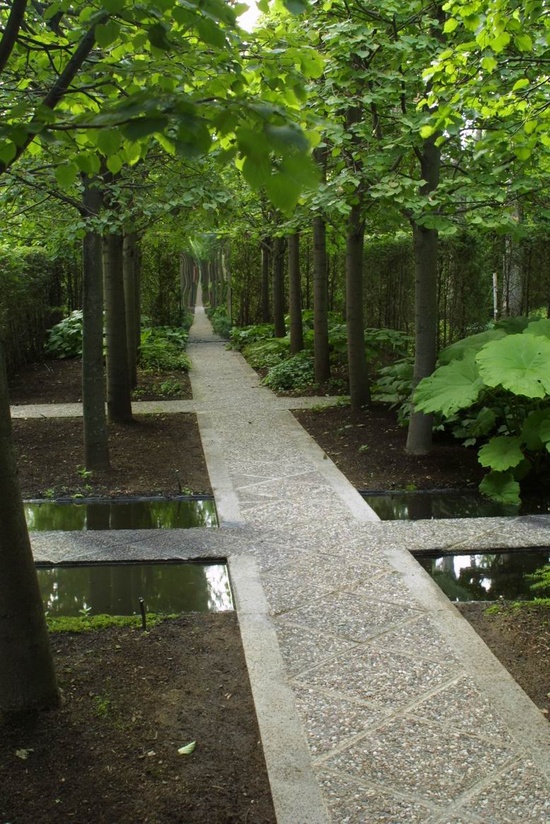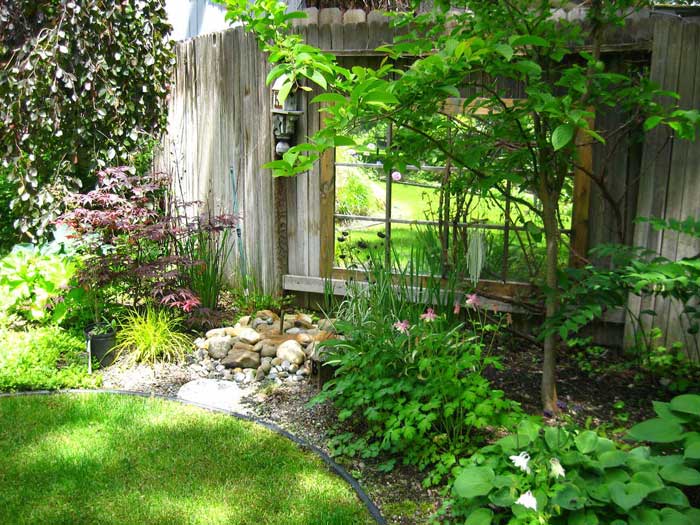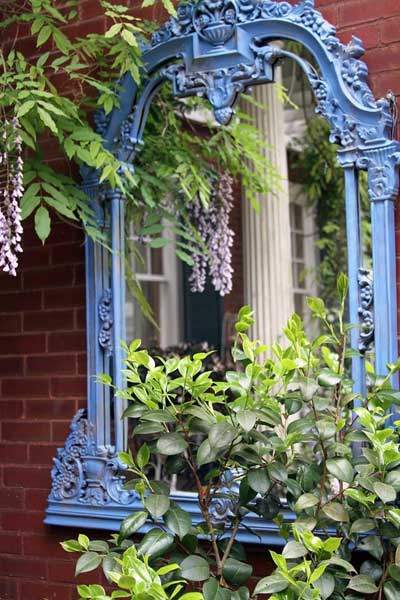Almost all of us are aware of the fact that a mirror is able to give more brightness and visually expand the narrow spaces.
Not many, however, have ever thought that this feature can also be used in the garden to obtain effects sometimes amazing.
Few people, unfortunately, can enjoy large and bright outdoor spaces.
Garden mirrors and optical illusions
Gardens, especially urban ones, are often surrounded by walls and can have an oppressive appearance.
In these cases, a strategically placed mirror can give the garden a more airy look and create optical illusions that seem to open windows and gates to other spaces; spaces that are nothing more than reflections, of course, but that nonetheless have the power to make our outdoor space more pleasant and livable.
The following video blatantly demonstrates the psychological effect created by a mirror-covered fence that separates, and at the same time unites, the lawn it borders.
This is an artistic installation by Alyson Shotz (for more details see the first photo in the photo gallery at the bottom of this article), if you think that such a fence is not reproducible with DIY, or that it has prohibitive costs, you are wrong, because new materials allow us to obtain the same effect with relatively low costs.
An important and banal consideration: a mirror, as such, reflects what is in front of it and it is therefore obvious that the choice of its location in the garden is of fundamental importance.
A mirror in the garden should reflect beauty, as far as possible. Therefore, before even thinking about using mirrors, we should learn how to design a garden properly.
If we are proud of the flower bushes we have placed in front of a gray and anonymous wall, then covering that wall with a mirror will reflect the beauty of our flower beds and we will be able to enjoy their beauty, virtually duplicated.
What mirrors to use in the garden?
Even before realizing the idea of enlarging our small garden using a mirror, we need to carefully consider what kind of mirror to choose. Now, the possibilities are basically two:
- traditional glass mirrors
- acrylic mirrors
The disadvantages of traditional glass mirrors in the garden
If we have an old mirror, perhaps one of those that entirely covered the door of a closet that we now want to replace, we can safely recycle it and put it in the garden to open a virtual door or window.
However, even smaller mirrors can be reused to create small portholes (if circular in shape) or small windows.
Smaller mirrors can also be sequenced and placed higher than a large mirror.
Glass mirrors, however, have a few drawbacks that must be taken into account.
First, they are heavy and difficult to place; second, they are fragile and easily attacked by mold if they are exposed to the elements.
If humidity infiltrates the back of the mirror, it is easy for it to end up causing the detachment of the thin reflecting foil.
Other aspects that discourage their use in the garden is the high cost and difficulty of processing: glass mirrors are difficult to cut if you do not have suitable tools, and even more difficult is to shape them to fit into niches or existing openings.
Finally, they are dangerous if they break.
For all these reasons it is better to avoid to use these mirrors in the garden, unless they are recycled mirrors that we would otherwise have to throw away.
The advantages of modern acrylic mirrors
Acrylic mirrors are sheets of variable format that, unlike glass, weigh 80% less but are, at the same time, ten times more resistant.
They are easy to cut, being sufficient to scratch them with a knife and then break them sharply and precisely in correspondence with the line created.
With acrylic mirrors it is easy to make curved cuts or special shapes, using a common jigsaw or, even better, a small cutter mounted on the Dremel.
They can also be drilled using a common drill with metal bits and, last but not least, they are flexible and can be used to cover curved surfaces, if the radius is large enough.
Acrylic mirrors in the garden can be glued using mirror adhesive and are also available in blue and purple colors.
The website that seems to offer the widest range of acrylic mirrors is Primrose.
Acrylic mirrors are of varying sizes and range from small ones of 60x60 cm, which cost about 50 USD, up to large sheets of 180x120 cm at a cost of about 140 USD.
The only disadvantage that could be attributed to these mirrors is that, when mirrored in them, the image may be less sharp than in traditional glass mirrors.
Considering, however, that these mirrors should be placed in the garden and are not used to make up or shave, we believe that this is a defect all in all not very relevant.
Tips on how to apply mirrors in the garden
First, whether it is glass mirrors or acrylic mirrors, the advice is to get help with the work.
Mirrors can be heavy and four hands are better than two when we have to fix them.
It is also very helpful to have someone hold the mirror in place for us and perhaps angle it, raise or lower it, according to our directions so that the mirror really reflects the best angle of our garden.
Let's remember to find an area of our garden that reflects morning or evening light well.
It is much better for the mirror to reflect the gentle morning or late afternoon light than the bright midday light.
These sunlit spots in close proximity to shaded areas are ideal for the placement of a mirror.
Other suggestions for the right location are to take advantage of wall niches, if any; they provide a natural frame, so to speak, and lend themselves well to holding a mirror, although it will need to be custom shaped to fit into the niche.
The frame of the mirror is very important!
If we really want to achieve a realistic effect we need to spend some time to create a wooden frame or other material that will frame the mirror.
Here you can play extensively with your imagination and even with recycling to create a DIY frame for the mirror that is also of great effect.
If we have an iron gate, perhaps old and rusty and we do not know what to do, remember that it can easily come in handy to be placed in front of and in contact with the mirror in order to create the illusion of a gate that opens onto another space in the garden.
Sometimes even a simple frame made of wooden slats and other internal slats that form a sort of grating, can give the illusion of a rustic window that opens to the outside.
If you then want special things then the advice is to go for shapes that you can find on the web. They range from gothic-style windows to green shutters and mirror cages.
Generally, the material with which these frames are made so special is the resin; plastic material printed with a remarkable realistic effect.
If you're looking for sources of inspiration, Pinterest offers several, here's the link:
Mirrors in the garden on Pinterest
Depending on the style of the garden it should be easy to buy or create yourself something that fits perfectly with it.
Once we have decided on the best location for the mirror, all that remains is to attach it firmly to the support.
Remember to spread a strip of silicone along the entire back perimeter of the mirror that will come into contact with the support.
Remember also that the support must be rigid and strong enough to hold the mirror sheet.
Whether we opt for an acrylic or a glass mirror we should remember that, as far as possible, we should try to protect it from the weather.
We have already seen how a good silicone sealant can prevent, as far as possible, the infiltration of water between the support and the mirror, but if we can also protect the mirror with a shelter or a cover that is not inappropriate to the context, this can only prolong the life of the mirror and reduce the cleaning operations.
Finally, we would like to give you a suggestion for those cases where the frame cannot fit into the support.
In cases like these we should try to make friends with nature, so that climbing plants, such as rose bushes or ivy, such as the American vine, can cover the wall and smooth the contours of the mirror frame so that it does not "stand out" excessively but looks, in fact, like a window or a door that opens onto another section of the garden.
An example of what should be obtained can be seen in the image above.
Finally, a gallery of ideas from which you can take inspiration; as you can see, the effects that can be obtained by placing a mirror in the garden can be really interesting and it is only a matter of declining them with respect to the needs of our garden.
Mirror garden ideas
1. The mirror fence
All one can say about this fence is that it creates a very impressive effect. Made with wood and acrylic mirrors, it seems invisible and creates a visual shock between what is on this side of the fence and what is on the other side.
Source: www.alysonshotz.com

2. Recycled mirrors
Two doors, originally intended for a shower, were placed horizontally to widen the perspective of this small, old garden.
Source: www.empressofdirt.net

3. Porthole mirror
Placed on a wall with no openings and enclosed in a circular frame, this mirror looks like a porthole looking out.
Source: driftwoodramblings.blogspot.it

4. Mirror wall
Mirror wall, Such a project is certainly not within the reach of the hobbyist. This is the study for a garden in Amsterdam made by CC-studio
Photo by John Lewis Marshall

5. Mirrored glass window
Another splendid optical effect created by a mirror fixed on the rusty frame of an old arched window.
Source: www.homelife.com.au

6. A large mirror in the garden
In this case a large mirror, which we could also find inside some restaurants, has been placed outside and mainly reflects the table and its diners.
Source: brabournefarm.blogspot.it

7. Infinite path
Incredible also this optical effect created with a play of mirrors by which a blind path seems to extend to infinity.
Photo by www.finegardening.com

8. Mirror Gate
Are you sure that what you see is an iron gate that opens to another part of the garden? Not at all, these are simple mirrors with the gate decorated on top.
Photo by www.sandedge.com

9. Mirror window
A simple wooden frame to simulate a window and behind a sheet of acrylic glass. The effect is amazing.
Photo by http://www.finegardening.com

10. Mirrored pathway
Another example of simulating a transition to another space using a well-placed mirror.
Photo from www.houzz.com

11. Mirror in cast iron frame
Fundamental, to get the maximum effect from a mirror placed in the garden, is the frame in which it is set.
Photo by deardaisycottage.typepad.com

12. Optical illusion
Niches and recesses on a gray and anonymous wall can prove to be perfect places to place a mirror.
Photo from pinterest.com



